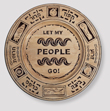Sukkot
These etrog boxes are also carved to be used. They hold the Etrog, the citrus fruit used during the holiday of Sukkot. The Torah commands in Leviticus 23:40, "You shall take on the first day the fruit of goodly trees (etrog), branches of palms, and boughs of thick trees (myrtle), and the willows of the brook and you shall rejoice before Adonai your God for seven days.
All four of these species associated with Sukkot are pictured on both boxes. The top features the etrog and the lulov with palm branches and willows. The myrtle is featured on the front panel.
Shabbot
According to Jewish tradition, God blessed and hallowed the Sabbath, the seventh day on which he rested after creation. Observance of the Shabbot is the 4th Commandment given at Mt. Sinai. Eating Challah, or braided bread, became a traditional part of the Shabbot Celebration. It is said that poor Jews in Eastern and Central Europe could only afford hard black bread all weeklong, but on Shabbas, they ate beautiful challahs.
The Challah Cutting Board was my first attempt at creating a more modern flavored carving.
Pesach
Pesach is a Holiday to both celebrate freedom as well as to remember that slavery still exists. The Passover Seder tells our story of how we went from Egyptian slavery to freedom.
 |
 |
 |
 |
 |
 |
| Box with Myrtle and Initials | Box with Three Species | Star of David, surrounded by geometric designs and Myrtle motif | Box with Sukkot, carved in Hebrew | Challah Board | Let My People Go |
